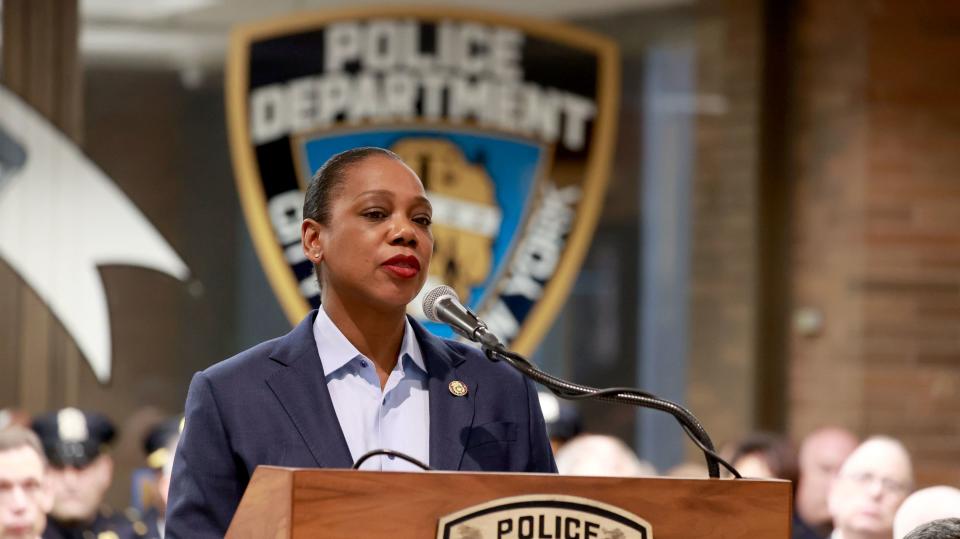NYPD Commissioner Keechant Sewell says cops’ unconstitutional stop-and-frisks far fewer than federal monitor claims
- Oops!Something went wrong.Please try again later.
- Oops!Something went wrong.Please try again later.
Police Commissioner Keechant Sewell on Friday shot down a federal monitor’s report that the NYPD teams tasked with keeping guns off city streets have made a high number of unlawful street stops that predominantly target New Yorkers of color.
“One hundred percent, I take exception (to the report),” Sewell said during an interview on NY1. “These reasonable suspicion stops are legal and effective. But they have to be done constitutionally.”
A report released Monday by Mylan Denerstein, a court-appointed watchdog overseeing the NYPD’s controversial stop-and-frisk tactics in years-old litigation, found that 24% of stops, frisks and searches by the NYPD’s Neighborhood Safety Team were unconstitutional.
Sewell disputed Denerstein’s findings Friday, claiming that she and her team looked at the same stops the monitor checked and found that the “error rate was only about 18%” — substantially less than what Denerstein found.
The illegal stops occurred, Sewell said, because the NYPD’s Neighborhood Safety Teams mistakenly believed they had reasonable suspicion to conduct the stops.
“Our professional standards bureau weekly goes over the body-worn cameras in the Neighborhood Safety Teams,” Sewell said.
Officers are asked to articulate what led them to stop and search a particular person, Sewell said. If supervisors believe the cops didn’t have a proper reason for the search or “see these stops are being handled inappropriately,” cops are instructed about their mistakes, she said.
Sewell added that she and Mayor Adams are taking Denerstein’s report “very seriously.”
Sewell had challenged the report when it was released, saying in a statement Monday that “the department disagrees with the conclusions of the Monitor with respect to some of the encounters the team reviewed.”
In her report, Denerstein cited her findings as “disappointing.” She found the Neighborhood Safety Teams — who wear modified uniforms similar to security guards and ride in unmarked cars — to be the least compliant of all officers on patrol, and department oversight to be “inadequate at all levels.”
Despite the monitor’s report, Sewell said significant progress has been made in street stops since the height of the stop-and-frisk era.
“In 2011, which was the high water mark for stops — we were at 684,000 stops at that time. Last year, we had just over 15,000,” the commissioner said.
While the number of reported stops has fallen sharply since the litigation that led to Denerstein’s appointment as a federal monitor was brought nine years ago, Denerstein discovered that racial disparities in the stops are as stark as ever.
Her report covered stops between April 1 and October 30, 2022. Of 419 encounters recorded on police officers’ body-worn cameras in 34 police commands, 97% of those stopped were Black or Hispanic and 92% were male.
Neighborhood Safety cops had reasonable suspicion to stop people 69% of the time — meaning they stopped three out of every 10 people unlawfully, the monitor found.
Police had a legal basis for only 63% of searches, the monitor’s study said. Out of 230 car searches, the study said, the Neighborhood Safety Teams recovered two weapons.
The monitor’s report reviewed stops by Neighborhood Safety Team members including lieutenants, sergeants and police officers.
The report noted that the NYPD has a different way of assessing the legality of stops. If a frisk is fruitful, the police department counts it as proper, even if the stop was unlawful. Of the 86% of searches precinct executives said were lawful, the monitor only found 46% to be so.
“Too many people are stopped, frisked, and searched unlawfully,” Denerstein wrote in the Manhattan federal court filing. “At the precinct level, sergeants, lieutenants and commanding officers fail to identify and correct the unconstitutional policing.”
Police use of stop-and-frisks is continuing this year.
New data issued Tuesday in a quarterly report the NYPD is required to provide to the City Council show officers made 4,153 stop, question and frisk stops citywide in the first three months of 2023 — the highest quarterly total since the last three months of 2015.
Roughly 70% of those stopped are Blacks or Black Hispanics, the data show. Another 23% are white Hispanic and 6% are white.
Mayor Adams’ first major policy announcement was to bring back an iteration of undercover cops like the NYPD’s disbanded anti-crime unit.
The plainclothes anti-crime cops were involved in some of the city’s most notorious police killings, including the 2014 chokehold death of Staten Island man Eric Garner. The units were shut down during the administration of former mayor Bill de Blasio.


